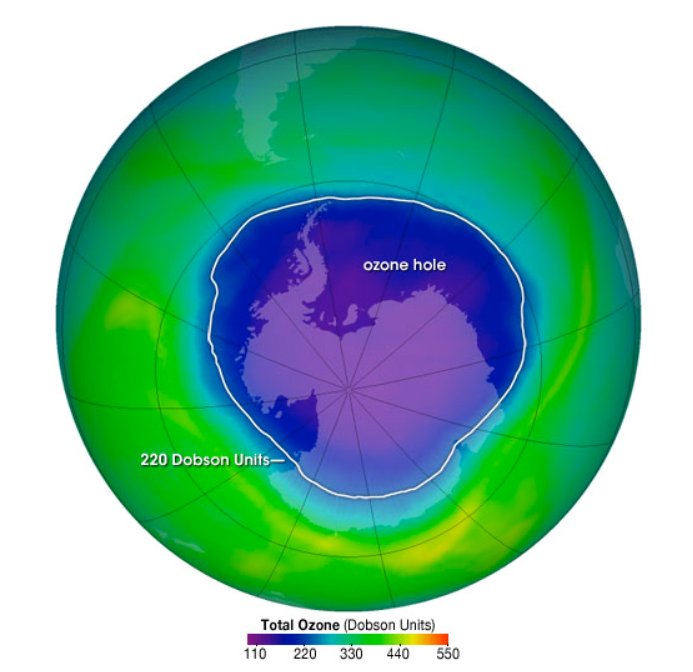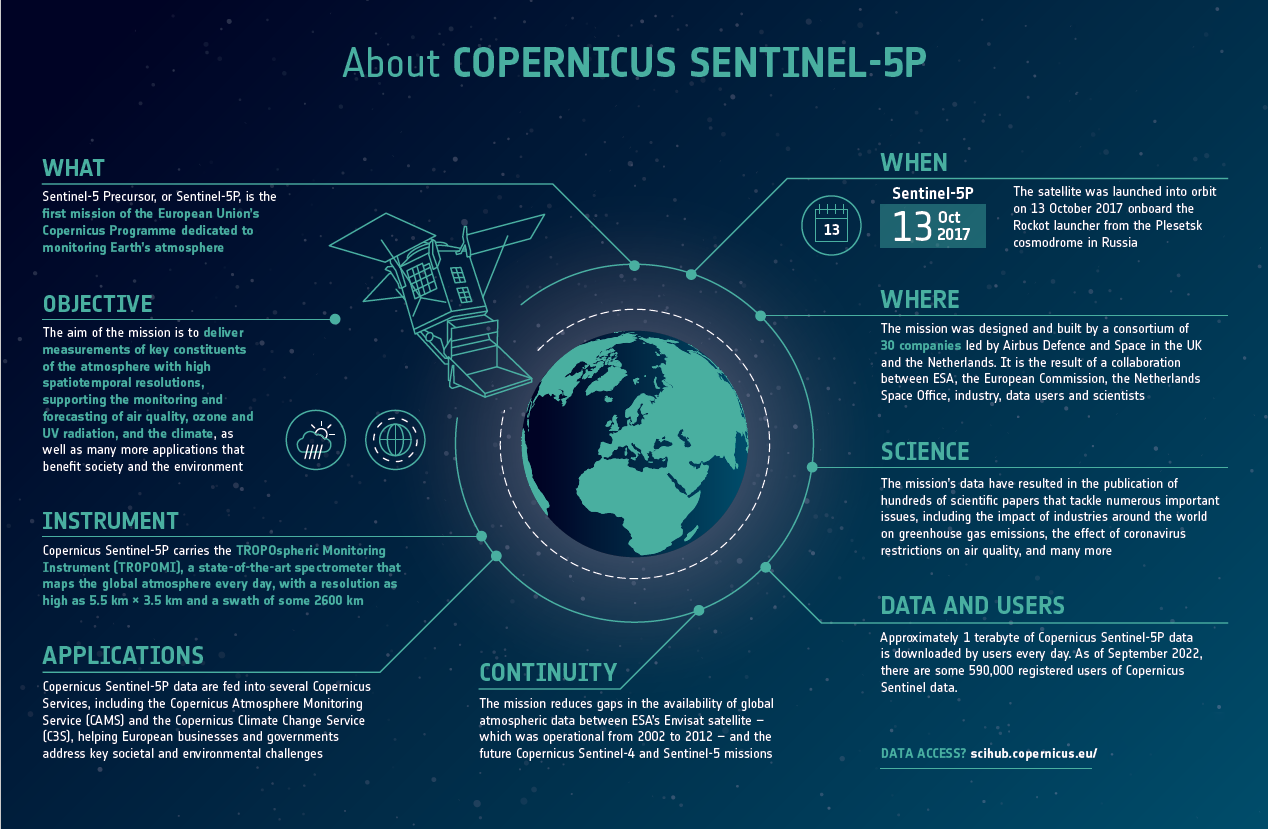Large Ozone Hole Detected Over Antarctica | 16 Oct 2023
For Prelims: Ozone hole, Volcanic eruptions in Tonga, Greenhouse gas effect, Montreal Protocol, World Ozone Day
For Mains: Mechanism Behind Ozone Hole, Ozone Holes and Climate Change.
Why in News?
Satellite measurements over Antarctica have revealed a massive ozone hole, or "ozone-depleted area," stirring concerns. The European Space Agency's Copernicus Sentinel-5P satellite captured this significant anomaly.
- While it is not likely to exacerbate warming on the surface of Antarctica, this phenomenon raises questions about its causes and potential ties to climate change.
What is the Ozone Layer?
- The ozone layer, found in the stratosphere (good ozone), acts as a protective gas shield that absorbs harmful ultraviolet (UV) radiation, safeguarding us from the adverse effects of excessive UV exposure.
- Skin cancer rates are significantly influenced by UV radiation, underscoring the importance of preserving the ozone layer.
What is an Ozone Hole?
- About:
- An ozone hole is a region of the stratosphere over Antarctica where the ozone layer is exceptionally depleted.
- The ozone hole is not technically a “hole” where no ozone is present. Scientists use the word hole as a metaphor for the area in which ozone concentrations drop below the historical threshold of 220 Dobson Units.
- The size of the ozone hole over Antarctica varies from year to year, typically opening in August and closing by November or December.
- This annual fluctuation is driven by unique climatic conditions over the region.
- An ozone hole is a region of the stratosphere over Antarctica where the ozone layer is exceptionally depleted.
- Mechanism Behind Ozone Hole:
- The opening of the ozone hole is a result of the Earth's rotation, which generates specific winds over the enclosed landmass of Antarctica.
- The polar vortex, a band of strong winds around the poles, plays a vital role in ozone hole dynamics.
- During winter, polar vortex forms due to temperature differences and acts as a protective barrier, keeping polar air separate from warmer, lower-latitude air.
- This isolation creates a cold environment for polar stratospheric clouds (PSCs), which trigger ozone-depleting reactions.
- The chemical reactions that occur on the surface of PSCs are responsible for the activation of chlorine and bromine compounds. These compounds, particularly chlorine, are catalysts in ozone-depleting reactions. When exposed to sunlight, they trigger the breakdown of ozone molecules.
- This isolation creates a cold environment for polar stratospheric clouds (PSCs), which trigger ozone-depleting reactions.
- The size and strength of the polar vortex directly impact ozone depletion. When it weakens in spring, mixing with warmer air from lower latitudes gradually closes the ozone hole, replenishing the ozone layer.
- The opening of the ozone hole is a result of the Earth's rotation, which generates specific winds over the enclosed landmass of Antarctica.
- Cause of the Ozone Hole in 2023:
- Scientists suspect that the substantial ozone hole observed in 2023 may be attributed to volcanic eruptions in Tonga during December 2022 and January 2023.
- Unlike conventional volcanic eruptions, which generally release gasses confined to the lower atmosphere, this eruption propelled a significant amount of water vapor into the stratosphere.
- This water vapor, in addition to other ozone-depleting elements like bromine and iodine, impacted the ozone layer through chemical reactions, altering its heating rate.
Note
- While the Antarctic ozone hole in 2023 is likely linked to a natural event, it's essential to acknowledge that in the 1970s, human activities, specifically the widespread use of chemicals called chlorofluorocarbons (CFCs), were responsible for significant ozone depletion.
- The use of these gasses as propellants in aerosol cans released chlorine into the stratosphere, contributing to ozone depletion.
- Ozone Holes and Climate Change:
- Ozone depletion is not considered a primary driver of global climate change. However, there are indications that rising global temperatures may influence the behavior of ozone holes.
- Recent instances of significant ozone holes have been linked to climate change, particularly the occurrence of wildfires.
- The increased frequency and intensity of wildfires, often fueled by climate change, inject more smoke into the stratosphere, potentially contributing to further ozone depletion.
- While ozone holes may have a cooling effect, reducing the greenhouse gas effect, (the loss of ozone means slightly more heat can escape into space from that region), they can also alter the progression of seasons, leading to prolonged wintertime conditions.
Note
- In response to the ozone depletion crisis, the international community recognized the need for action, leading to the Vienna Convention in 1985 and the subsequent Montreal Protocol in 1987.
- World Ozone Day(16th of September) is observed every year to commemorate the signing of the Montreal Protocol.
What is Copernicus Sentinel 5P Satellite?
UPSC Civil Services Examination, Previous Year Question (PYQ)
Q1. Which one of the following is associated with the issue of control and phasing out of the use of ozone depleting substances? (2015)
(a) Bretton Woods Conference
(b) Montreal Protocol
(c) Kyoto Protocol
(d) Nagoya Protocol
Ans: (b)
Q2. Consider the following statements: (2012)
Chlorofluorocarbons, known as ozone-depleting substances, are used
- in the production of plastic foams
- in the production of tubeless tyres
- in cleaning certain electronic components
- as pressurizing agents in aerosol cans
Which of the statements given above is/are correct?
(a) 1, 2 and 3 only
(b) 4 only
(c) 1, 3 and 4 only
(d) 1, 2, 3 and 4
Ans: (c)


